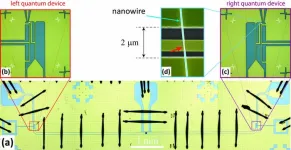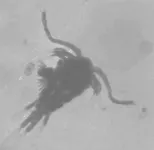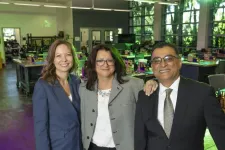(Press-News.org) Quantum communication and quantum computing operate based on quantum bits (qubits) as the smallest unit of information — related to bits in a classical computer. Of the many different approaches currently being investigated around the world, one promising option is to use Andreev pair qubits.
These qubits are formed at interfaces between a metal and a superconductor in a process known as Andreev reflection. Here, an electron from the metal enters the superconductor, where it becomes part of an electron pair (a Cooper pair) — while a hole, which behaves like a positive particle, is reflected back into the metal. Based on this process discrete pairs of bound states are formed at the interface of these materials. They are known as Andreev bound states and can serve as the basis states of a qubit. These states are relatively robust to outside perturbations, and the coherence time — the time for which superposition is maintained — is relatively long. They can also be readily controlled and incorporated into modern electronic circuits. All of these factors are advantageous for developing reliable and scalable quantum computers.
Exchange between two quantum systems
The researchers have now achieved a strong quantum mechanical coupling between two Andreev qubits, each localized in a semiconducting nanowire. The results show excellent agreement with theoretical models.
“We coupled the two Andreev pair qubits at a large distance from one another at the two ends of a long, superconducting microwave resonator. This allows the exchange of microwave photons between the resonator and the qubits,” explains Professor Christian Schönenberger from the Department of Physics and the Swiss Nanoscience Institute of the University of Basel, whose team carried out the experiments.
The microwave resonator can be used in two different ways: In one mode, the qubits can be read out via the resonator, providing the researchers with information on their quantum state. A second mode is used to couple the two qubits to each other, allowing them to “communicate” without losing microwave photons. The two qubits are then no longer independent of one another but rather share a new quantum state — which is vital for the development of quantum communication and quantum computers.
“In our work, we combine three quantum systems so that they can exchange photons between each other. Our qubits themselves are only about 100 nanometers in size, and we couple them over a macroscopic distance of 6 millimeters,” says Dr. Andreas Baumgartner, one of the article’s co-authors. “By doing so, we were able to show that Andreev pair qubits are suitable as compact and scalable solid-state qubits”.
This work was carried out by teams from the universities of Basel, Copenhagen, Karlsruhe and Yale as part of the European FET Open project AndQC.
END
Strong coupling between Andreev qubits mediated by a microwave resonator
2024-10-03
ELSE PRESS RELEASES FROM THIS DATE:
UNF biological sciences professor receives NIH grant to study muscle atrophy
2024-10-03
Jacksonville, Fla. – A University of North Florida biology professor has been awarded a prestigious four-year National Institutes of Health (NIH) grant totaling over $720K to study the functional role of an enzyme called dual-specificity phosphatase 4 (Dusp4) in skeletal muscle atrophy.
Dr. David Waddell’s NIH-funded research project will help contribute to knowledge about skeletal muscle atrophy associated with neuromuscular disorders, neurodegenerative diseases and aging. Skeletal muscle atrophy is a decrease in muscle mass that occurs when protein degradation exceeds protein ...
Child Health Day 2024: influenza vaccine protects children from infection and hospitalization for the disease, Spanish study shows
2024-10-03
A study published on Eurosurveillance has demonstrated that Spain's influenza vaccination campaign for children aged 6-59 months during the 2023/24 season was effective in preventing acute respiratory infections (ARI) and hospitalisation, as vaccination was recommended for this age group at the national level for the first time.
In the context of Child Health Day 2024, this research emphasises that continued efforts should be made to increase vaccination coverage among children for future seasons.
Context and methods
Influenza A was dominant in the 2023/2024 season, ...
Announcing the 2024 Glenn Foundation Discovery Awards: Jeffrey Friedman, MD, Ph.D/ (the Rockefeller University) and Myriam Heiman, Ph.D. (MIT)
2024-10-03
Santa Barbara, CA and New York, NY -- The Glenn Foundation for Medical Research (GFMR) and the American Federation for Aging Research (AFAR) are pleased to announce the 2024 recipients of the Glenn Foundation Discovery Awards: Jeffrey Friedman, MD, PhD (Professor, The Rockefeller University and Investigator, Howard Hughes Medical Institute) and Myriam Heiman, PhD (Associate Professor of Neuroscience, Massachusetts Institute of Technology).
The Glenn Foundation Discovery Award supports research projects with strong potential to develop pioneering discoveries to understand ...
Stem cell transplants close macular holes in monkeys
2024-10-03
Human stem cell transplants successfully repaired macular holes in a monkey model, researchers report October 3rd in the journal Stem Cell Reports. After transplantation, the macular holes were closed by continuous filling of the space with retinal tissue.
“We confirmed for the first time in a non-human primate model that embryonic stem-derived retinal organoid sheet transplantation facilitates the closure of macular holes,” says senior study author Michiko Mandai of the Kobe City Eye Hospital. “Our results suggest that this method could become a practical, safe, and effective ...
Our brains divide the day into chapters. New psychology research offers details on how.
2024-10-03
The moment a person steps off the street and into a restaurant—to take just one example—the brain mentally starts a new “chapter” of the day, a change that causes a big shift in brain activity. Shifts like this happen all day long, as people encounter new environments, like going out for lunch, attending their kid’s soccer game, or settling in for a night of watching TV.
But what determines how the brain divides the day into individual events that we can understand and remember separately? That’s what a new paper in the journal Current Biology aimed to find ...
Fear of cancer recurrence in adult survivors of childhood cancer
2024-10-03
About The Study: Decades following treatment, one-third of childhood cancer survivors in this study reported elevated fear their cancer will recur or a subsequent malignant neoplasm will develop. Findings suggest that fear of cancer recurrence should be routinely screened, and clinically significant symptoms intervened upon as a part of survivorship care.
Corresponding Author: To contact the corresponding author, Nicole M. Alberts, PhD, email nicole.alberts@concordia.ca.
To access the embargoed study: Visit our For The Media website at this link https://media.jamanetwork.com/
(doi:10.1001/jamanetworkopen.2024.36144)
Editor’s ...
AI algorithm for subclinical breast cancer detection
2024-10-03
About The Study: In this retrospective cohort study of women undergoing screening mammography, mean absolute artificial intelligence (AI) scores were higher for breasts developing vs not developing cancer 4 to 6 years before their eventual detection. These findings suggest that commercial AI algorithms developed for breast cancer detection may identify women at high risk of a future breast cancer, offering a pathway for personalized screening approaches that can lead to earlier cancer diagnosis.
Corresponding Author: To contact the corresponding author, Solveig Hofvind, PhD, email sshh@kreftregisteret.no.
To access the embargoed study: ...
Study identifies potential novel drug to treat tuberculosis
2024-10-03
Highlights:
Mycobacterium tuberculosis, which causes tuberculosis (TB), is a threat to public health.
A new study identified that a semi-synthetic compound can be derived from natural compounds and shows potent activity against M. tuberculosis, including multi-drug resistant strains.
This is a promising step toward new potent treatment for TB.
Washington, D.C.—A new study published in the American Society for Microbiology journal Microbiology Spectrum demonstrates that a novel semi-synthetic compound can be derived from ...
UTEP study: Zooplankton go “Eew!” to cleaning feces contaminated water
2024-10-03
EL PASO, Texas (Oct. 3, 2024) – Scientists at The University of Texas at El Paso and Stanford University were recently surprised to find that the natural community of zooplankton — tiny, aquatic animals known to graze on bacteria — present in freshwater and saltwater do not clean water that is contaminated with fecal microorganisms.
The research, published today in the biology journal mSphere, reveals important insights about the limitations of zooplankton in treating bodies of water that have been contaminated with fecal organisms, the team said. A 2017 U.S. water quality inventory ...
FAU awarded $10M to train people with disabilities for in-demand tech jobs
2024-10-03
The rising demand for tech jobs presents an outstanding opportunity for growth and inclusivity in the industry. Developing accessible training programs tailored for individuals with disabilities can foster a more diverse workforce. Florida Atlantic University’s College of Education and the College of Engineering and Computer Science have received a $9,961,460 grant from the United States Department of Education’s Office of Special Education and Rehabilitative Services to increase the capacity and participation of transition-age youths and working-age adults with disabilities in high demand technology jobs locally and nationally. ...


